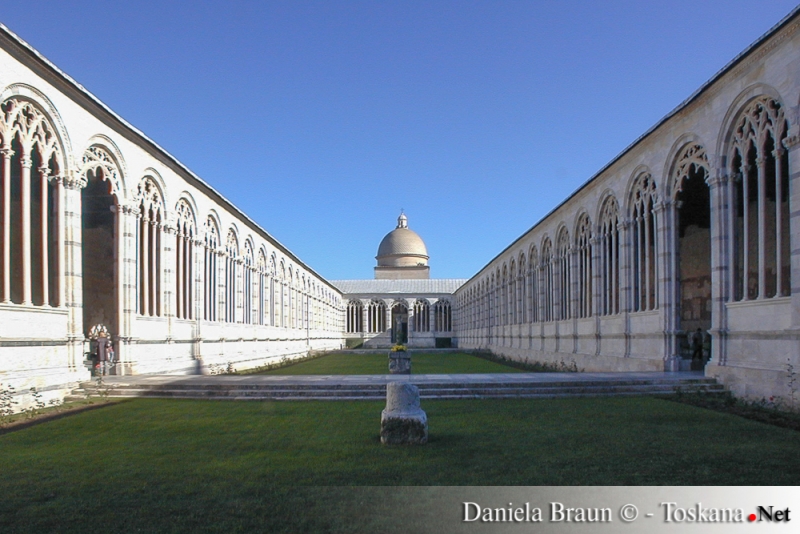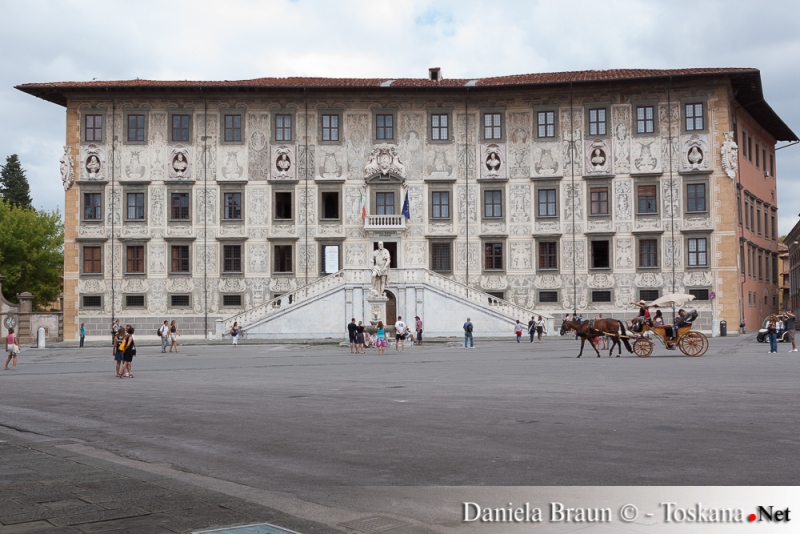The Province of Pisa borderes north with the Province of Lucca, whereas south-east it borderes with the Provinces of Florence and Siena. The south-west border is occupied by the Province of Livorno and the south-east border by the Province of Grosseto.
From the 5th century B.C. Pisa was an Etruscan settlement on the sea. From the second century B.C. on followed the Romans who built the Portus Pisanos, becoming an important ship base. Besides the sarcophagus and the ruins of the spas, nothing remained from the Roman empire. After the Roman decline, Pisa was also for the Goths, the Langobards and the Carolingians a harbour town of great importance for the battles against the Saracens. The Pisans conquered later Sardinia, Reggio Calabria, Palermo, the Islands of Lipari, Carthagin and in the 12th century the Balears. The battles with the Saracens were lasting a long time, thus Pisa could develop, becoming in the 11th century one of the four powerful Italian Sea Republics (Genoa, Venice, Pisa, Amalfi). With the gold of the Saracens they financed the building of the cathedral. In the same period started also the history for which the town of Pisa attracts every year attracts visitors of all over the world: the building of the bell tower of the cathedral, known as the Tower of Pisa.
All the monuments of the square were strictly build with carrara marble. After six years of building works, arrived on the third floor, architect Bonanno Pisano stopped works, because of a sinking of the ground, leading to the inclination of the tower. Today it is believed that not only the earth conditions but also the weight of the tower that according to some recent calculations of technicians should have a weight of more than thousand of road trains and this on such a small surface. The obtained wealth allowed Pisa to found colonies in North Africa, Spain and on the south coast of Asia Minor.
Particularly from Asia Minor arrived new artistic forms and natural theories leading to the rennovation of the antique Langobard style and the Pisan-Roman style was born. Pisa placed itself on the Ghibelline’s side and obtained by Frederic I Barbarossa the concession of the coastal area from Portovenere until Civitavecchia, as well as the feudal rights over Naples, Amalfi, Salerno, Calabria and Sicily. There have always been disputes with teh near Lucca, Genoaand Florence. Lucca and Florence, both in the hands of the Guelfs, joined against Pisa. At the end of the 13th century, ninety years afterwards, another architect Giovanni di Simone, started again with the works of the leaning tower, trying to correct the inclination.
In 1284, Pisa lost the battle of Meloria against the Genoese and with this nearly the whole fleet. In order the win the battle they made use of a trick: the Genoese entered with 60 ships the Port of Pisa. Other 40 ships were hidden in a bay nearby, underneath Montenero. The Pisans, convinced to win the battle took 102 ships. Suddenly arrived the other 40 hidden ships and unexpected turn made them loose the Pisan fleet.
This event took to the decline of the town. This meant also financial problems for the building of the tower. In spite of all, the tower was finished in 1350 with the seventh floor, reaching a height of 56 m. In this period, the harbour town of Pisa, because of detritus of the Arno river,was already 8 km away from the sea. In the beginning of the 15th century, Pisa was defeated again, but this time by Florence. Only under the Medici Pisa could reflourish. In 1472 was re-established the university that was ready to decline.
Pisa is also birthplace of Galileo Galilei, astronomer, physicist, mathematician and founder of the experimental method. He already discovered in 1583 the “law of isochronism of the pendulum§” and invented also the hydrostatic balance. Seven years afterwards, he was professor of mathematics at Padova University, where he improved the telescope with which he saw the moon’s surface, the constitution of the Milky Way, the Venus phases, the rotation of the sun around its own axis as well as the four Jupiter satellites. After the death of the last member of the Medici family, the government passed to the Lorraine. The Second World War bombings destroyed great part of the Camposanto, churches and palazzi.












Leave A Comment